Dispatches from Sri Lanka
Anonymous
On July 9, hundreds of thousands of Sri Lankans stormed and occupied a number of key government buildings, forcing President Gotabaya to flee the country and resign. This was the climax of a months-long uprising triggered by the worst economic crisis the country has seen since Independence. At the center of the protests is a sprawling occupation in the heart of Colombo, the island country’s capital.
When the dust settled, then-Prime Minister Ranil Wickremesinghe, a close ally of the Rajapaksa family, was elected president by Parliament on July 20. The following night, the last occupied government building was cleared out by soldiers, along with a part of the main protest camp. In the weeks since a wave of repression has been unleashed, with numerous activists either in jail or in hiding. As we publish this, the police are threatening to evict the occupation.
In the aftermath of the July 22nd raid, Ill Will conducted two interviews with anarchists in Sri Lanka about their views of the uprising: its limits, its horizons, and what the next phase might look like. The first interview was conducted via correspondence with an anarchist and journalist based in Kandy, Sri Lanka’s second largest city. The second was taken in a coffee shop in the suburbs of Colombo with J. and Z., two anarchists involved in a mutual aid distribution tent at the occupation and who have been on the front lines of the protests from early on.
Other languages: فارسی, čeština 1 a 2, Português
Kandy
Ill Will: Can you share your thoughts on the current situation?
Even after Gota’s resignation, Sri Lanka is stuck with the same bunch of politicians. The new President, Ranil Wickremesinghe, finagled his way into power on the back of this public coup and has reinstalled the same cabinet. Millions of Sri Lankans are disappointed with this turn of events after months of protests. Some are even accusing the protest movement of being some sort of fifth column for Wickremesinghe and his Western-backers. Meanwhile, Wickremesinghe is exercising the full might of the state by declaring emergency regulations, giving the military and police powers to crack down on dissenters. Protesters say they are going to fight on, but nobody is quite sure how, given Wickremesinghe's extraordinary talents as a cunning politician and his fierce reputation of brutally neutralizing leftists and activists during the Janatha Vimukthi Peramuna1 (JVP) insurrection in the late 1980s.2
Can you tell us a bit about yourselves and your background?
Prior to Occupy Colombo, I was involved in the local environmental scene. Many people in the environmental groups were social activists. We often had conversations about far-left and radical politics. So before the Gota Go Home protests we had affinity with like-minded people, but we did not have a "group" per se.
How were you first exposed to anarchist politics?
In 2016, I entered the workforce and quickly grew disgruntled with my job. This pushed me towards leftist Facebook groups. I started reading communist literature and during that time the whole right-wing populist wave, with Trump, Bolsanaro, Duterte and Le Penn, unfolded. As I got more into leftism, I eventually started reading Kropotkin and the works of other anarchist writers. I also discovered websites such as Crimethinc and Adbusters, which gave me insight into left-libertarianism. The more I researched the rich history of Anarchism, such as the Spanish Civil war and the EZLN movement in Southern Mexico, the more I was convinced that another world was possible.
Is there an anarchist tradition or scene in Sri Lanka? Are there other groups that you are in touch with?
There is no anarchist movement in Sri Lanka, but it does have a lot of leftist history. There were two Maoist-inspired insurrections launched by the JVP in the early 1970s and the late 1980s. Most political parties in Sri Lanka are progressive and leftist in name only, and were formed as a reaction against Western imperialism and the country's colonial past. However, just like socialist regimes in South America, these so-called progressive governments and parties have always been reactionary and statist to the core and do not care about the actual working class.
But there are anarchist tendencies in Sri Lankan society. These tendencies came out in the open as a result of this year’s financial crisis and protest movement. But no faction, party, or group openly subscribes to anarchism or holds anarchist views in Sri Lanka. We are not in touch with anarchist groups abroad because we are not properly organized ourselves and only follow individual activists on social media.
What has your involvement in the protests and at the occupation looked like?
I joined small street demonstrations in the lead-up to the uprising in Mirihana, but I was not personally there at the moment it kicked off.3 I helped out the activists and protestors at the GotaGoGama occupation when it was first formed. The first few weeks were phenomenal — it was probably the first time that Sri Lankans witnessed a mass occupation protest. There were supply tents distributing free food to protesters, occupiers, and visitors; it was a good example of mutual aid and solidarity. The protests were generally peaceful with just a few confrontations with riot police.
Sri Lankans are mostly unaware that police and soldiers are there to protect the state. As a result, many were openly fraternizing with the police and thought that they were "just doing their job." Anti-police sentiments started to grow once the financial crisis really started to bite. Then the heavy-hand of the state was demonstrated in full force.
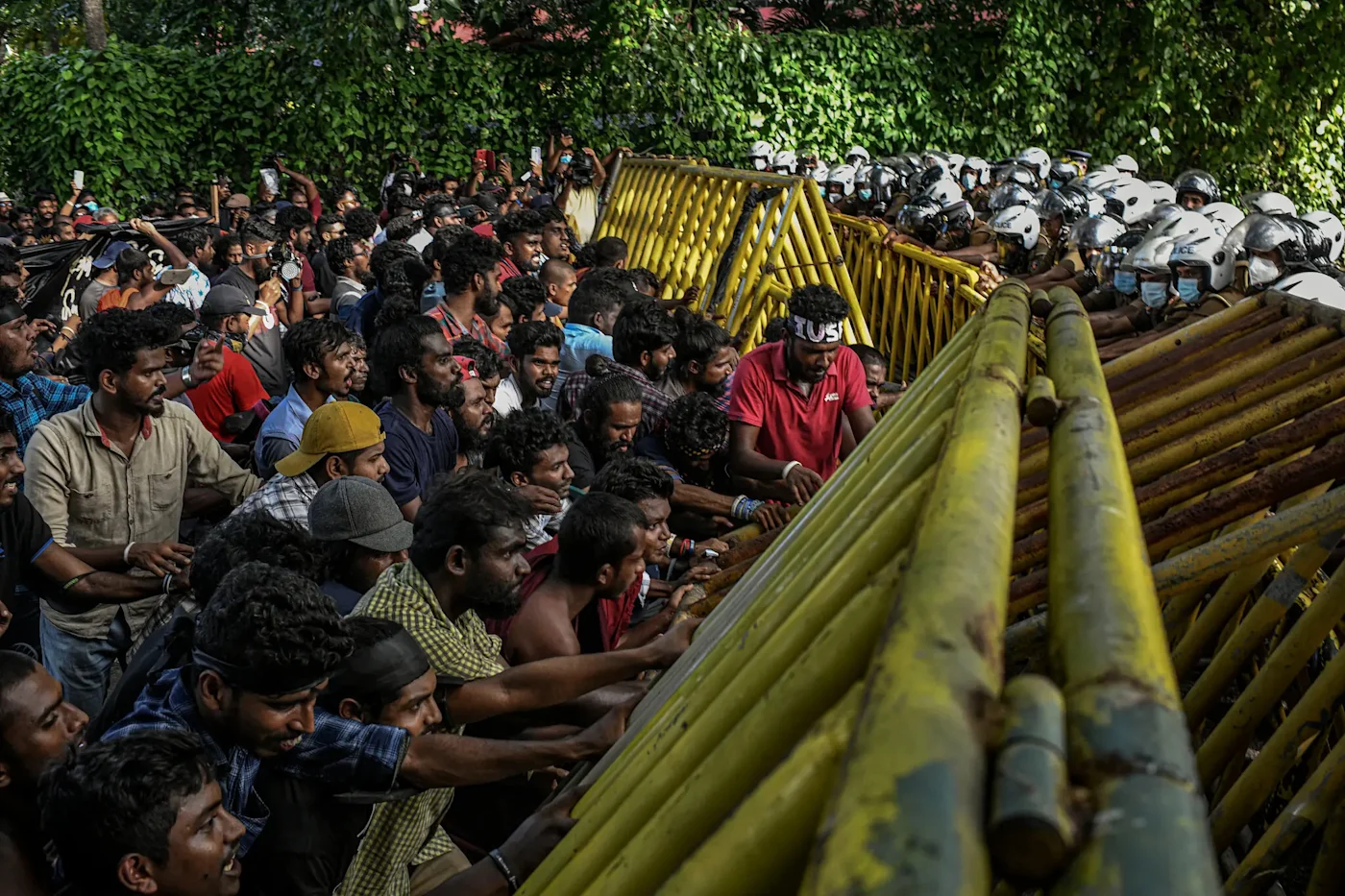
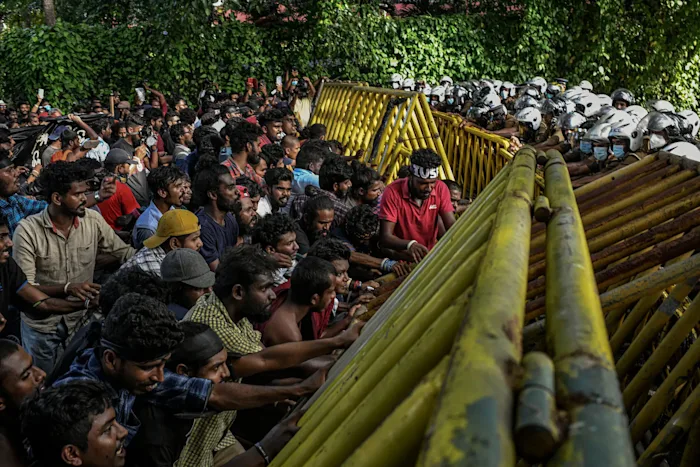
With the exception of far-leftists, Sri Lankans are generally sympathetic to police and security forces. Distriburbingly, many in the Sinhalese majority see the military as their "saviors" for crushing Tamil separatism during the civil war. But when the truncheons started landing on their heads on July 22, they were baffled. Some cried out: "You are supposed to protect us!" They were oblivious to the fact that the police and military are instruments of the state.
What are some of the debates and different perspectives that emerged in the movement, or within your own group?
We had debates about tactics and politics. I tried to educate some of the occupiers on anarchist ideas, but this always fell on deaf ears. The few occupiers who claimed to be anarchists didn’t bother to be informed or have an inclination to be organized. The protesters more or less thought that their popular movement had bargaining power after they deposed Gota. They assumed that the troops and police would stand down and let them occupy state buildings and dictate changes. But coming this far is a miracle. I see it as a first step to winning many battles.
Leftist politics, like I said, have been made unpopular here by pseudo-leftists parties and groups, such as the JVP. Most youth view socialist ideology with contempt. For them socialism is for boring college professors, annoying undergrads, and bullshit politicians whining about "Western imperialism" from the podium. For young people, the Democratic Socialist Republic of Sri Lanka is a failure compared to more prosperous capitalist nations. The Asian tigers, such as Hong Kong and Singapore, are viewed as what Sri Lanka could have been if it had fully embraced free-market policies. But Sri Lankans tend to overlook the fact that Hong Kong and Singapore are brutal police states, incompatible with laid-back and easy going islanders such as themselves. Sri Lankans are not aware of anti-authoritarian leftism. They haven't heard of places like Rojava, the Ukrainian Free State of 1918, Catalonia in the 1930s, or current day Chiapas.
What were some of the big turning points in the movement?
The biggest turning points in the movement were the days of May 9 and July 9. On May 9, the former Prime Minister Mahinda Rajapaksa unleashed his thugs to dismantle the protest sites in front of Temple Trees and Galle Face.4 As soon as these goons started to attack Gota Go Gama, people from nearby offices, neighborhoods and even port workers came to the occupiers' rescue.5 What followed was a night of retribution where many mansions and properties belonging to government politicians were torched. Rajapaksa's supporters were beaten and thrown in the Beira Lake in Colombo. July 9 was dubbed the "Endgame," after the Marvel movie, and rightfully so. Thousands converged on the Presidential Palace and the Presidential Secretariat and the rest was history.
What do you see as some of the missed opportunities of the struggle? What have been some of the limits or obstacles that the struggle hasn’t been able to overcome?
Anarchists, or those with anarchist ideas, did not organize well to collectively join the protests and support the strike against the state, or to educate the people coming to the occupation. Liberals and other political tendencies in the protest movement only wanted to reform the state by kicking out the current lot and writing a new constitution. We anarchists understand that if all we accomplish are short-term agreements with the capitalists that actually control the state, Sri Lanka's problems will only continue. We saw how much these corporations are devastating the environment to make way for plantations, factories, and resorts. We understand that any compromise with the bourgeoisie will end in failure.
Language is one of the main barriers to spreading our message. We need to find dedicated translators that can put anarchist literature into Sinhala and Tamil mediums. Anarchists in Sri Lanka, being a small group, and seeing the reluctance of people towards anarchism, have generally postponed making any Sinhala or Tamil zines.
Forms of green anarchism, anarcho-primitivism, and guerrilla gardening have been appealing to Sri Lankans given our pastoral culture and verdant island home. A lot of our people yearn for the simplistic times when life was in balance with nature.
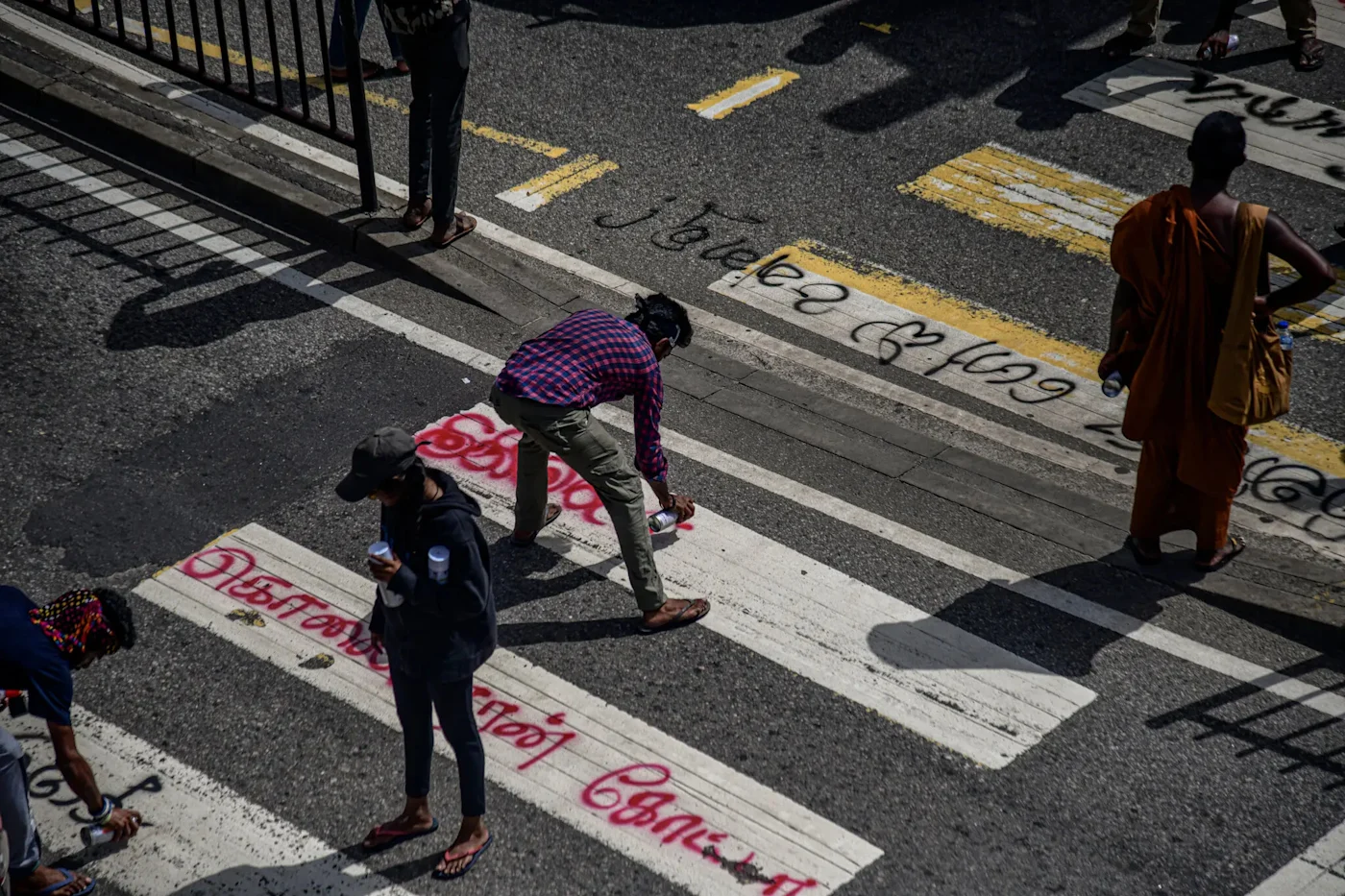
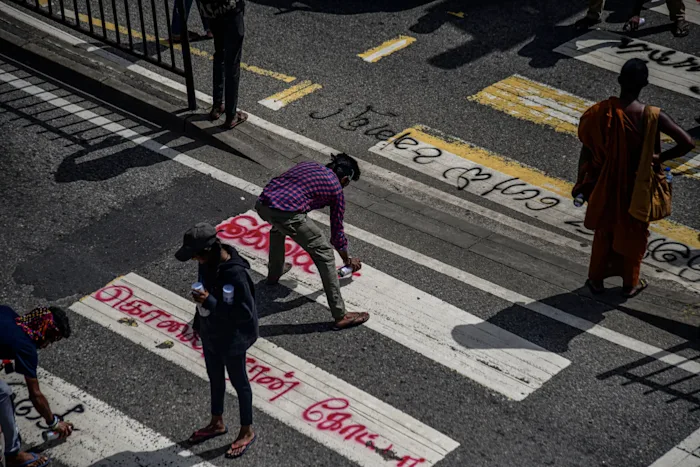
Officially, the protest movement adheres to the principle of non-violence. But ironically, its most important moments, May 9 and July 9, have been defined by violence and aggressive direct action. The most important "frontline troops'' in these protests are the Inter University Students Federation (IUSF), colloquially called Anthare. The Anthare employ a very aggressive style of protesting and often lead the charge against riot police. The Anthare are the remnants of the JVP's hard-leftist student movements and are accused by liberals of being bent on destruction. The liberals meanwhile walk behind the Anthare till all teargas clears and the hard fighting is over, and then take all the credit.
What do you expect this next phase of the struggle to look like?
Given Ranil Wickremsinghe's reputation as a brutal enforcer and sly politician, the movement will face many challenges that it hadn't faced in the previous months. Reactionary and fascistic forces are regrouping as we speak and will launch counter attacks to avenge the humiliation they faced on May 9. We hear that the state apparatus is identifying key protest leaders in the hopes of either intimidating or bribing them. We also know that political agents and government plants are working hard to divert and discredit public dissent.
What would it mean to win?
The ultimate win would be for the people of Sri Lanka to rise up as one, overthrow their political masters, and seize the means of production. The island would be organized around collectives of fully autonomous workers and farmers, free to make their own decisions and build a truly libertarian land. Sri Lanka existed in a self-reliant way for centuries. If the country is free from the tyranny of the state and capital, it would be a virtual utopia of people living for themselves and not for some bullshit nation-state ideal.
What are the lessons from Sri Lanka for struggles elsewhere?
Sri Lanka teaches that spontaneous protests can weaken the will of a tyrannical regime. It also teaches the importance of solidarity because it united many political currents and ideologies around one purpose, like the Spanish Civil War.
What can people outside of Sri Lanka do to support?
We need more anarchists from abroad to visit us and teach us about organization. Learning from books is alright, but we are severely limited when it comes to experience. We would love to learn from Indigenous uprisings like the one in Chiapas, Mexico, and from anarchists in Greece about how they organized during the financial crisis there.
We also severely lack political resources such as access to political literature. We are looking for a good printer so we can make zines, posters, and stickers to spread the word. Personally, I think that the first step of organizing here would be for us to build a little media center with a printer and computers so that we can network with anarchists abroad and print material. Then, once our groups are big enough, we can move to doing direct actions. Before July, some of us had plans to do banner drops, but doing graffiti is especially challenging due to the current emergency regulations. Even small offenses can be blown out of proportion with activists looking at long court battles and lengthy jail time. Travel and mobility are huge issues we face at the moment due to the fuel shortages in Sri Lanka. Some of us are using bicycles to get around, but even the price of bicycles went up due to huge demand.
What do you plan to do now?
Organizing ourselves into affinity groups and planning our next moves is what is needed right now.
(July 26th, 2022)
Colombo6
Can you first just share your thoughts on the current situation?
Honestly, we all are experiencing some level of fear because of the state’s crackdown and recent witch hunt. But we are also frustrated and exasperated that after almost four months of protesting, we haven't really come close to achieving what we set out to do. There's still a large portion of the population that feels that we have won simply because we sent Gotabaya and the Rajapaksas home. First of all, that was a symbolic victory. And secondly, they haven't really been sent home, so long as Ranil Wickremesinghe remains in power; they're just behind the scenes, waiting for the right moment to step back in. So we're in a kind of wait-and-see phase.
It feels like a premeditated game that they're playing with the Rajapaksas and Ranil in power right now. There are so many things that could be done presently to address the crisis that this country is in. Yet their focus has primarily been on cracking down on demonstrations and going after protesters.
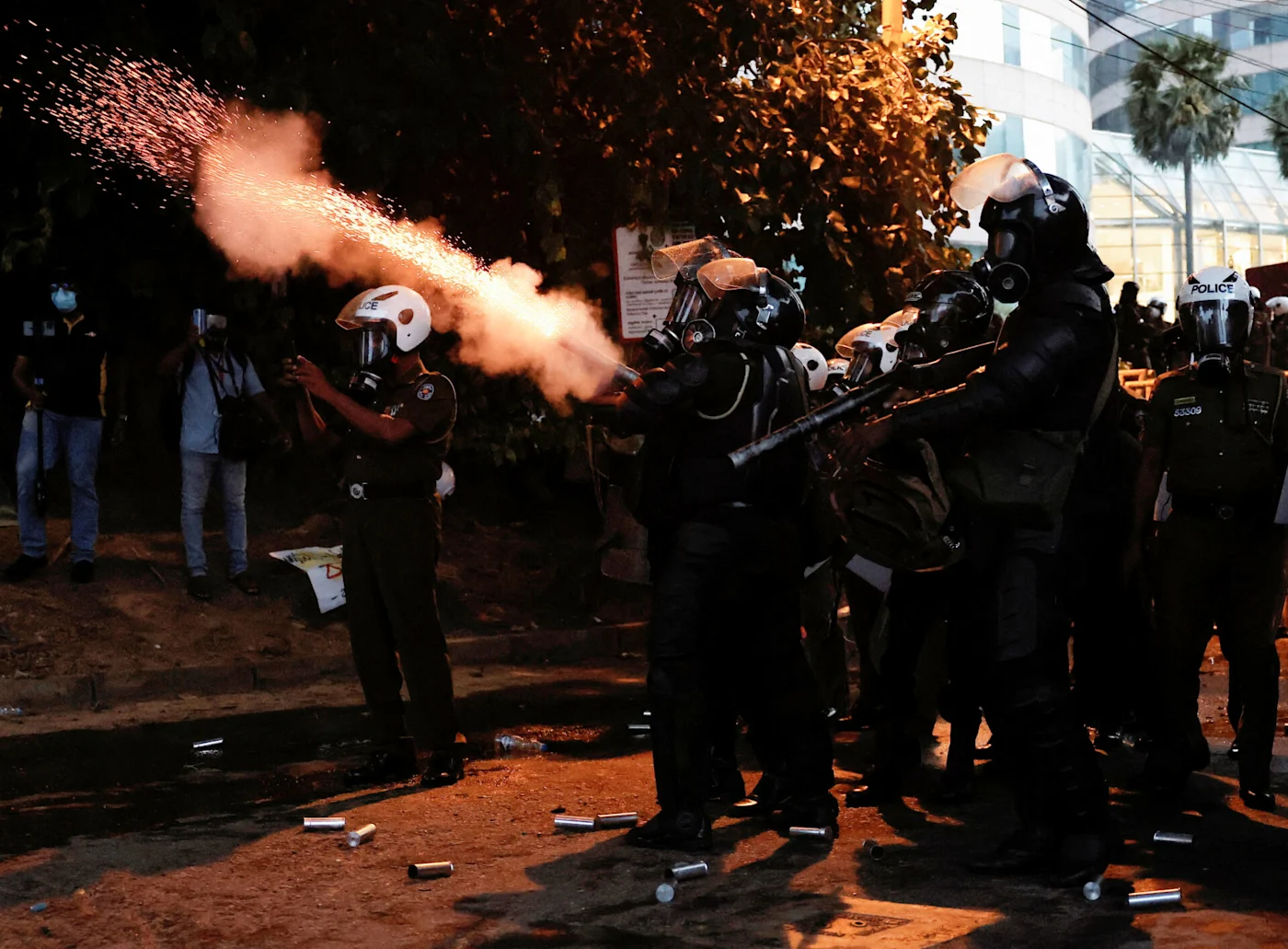
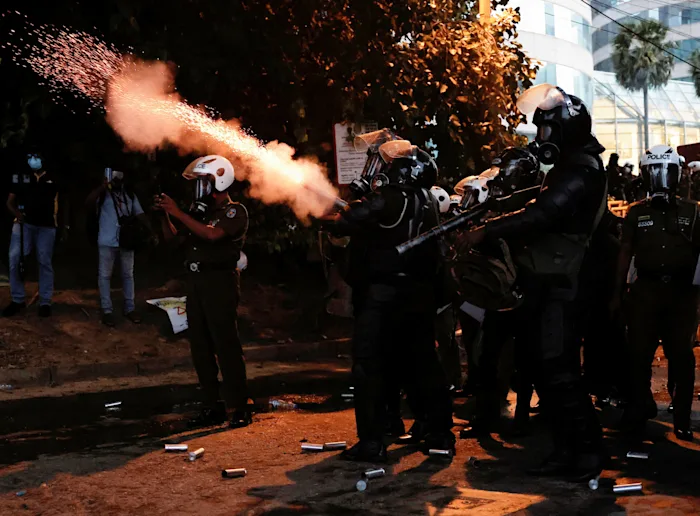
Ranil, who is one of the most failed politicians in Sri Lankan history, has been involved in numerous scams and allegations of scams, in addition to being linked to the torture camps back in the 80s. He was not even voted into the Parliament in his own constituency. Nobody wanted Ranil to come to power. They knew he was just there to protect the Rajapaksas. The deck of cards just got reshuffled.
Can you say a little bit about what the repression looks like right now?
People are being arrested for their involvement in the Aragalaya. A state of emergency was declared, which is being used as a pretense to arrest whoever they like at any moment. They don't even need a warrant to pick you up. We saw that guy Danish Ali being dragged off a plane. They're going after anyone that was noteworthy, anyone in videos that went viral. Even the guy that counted the money that was found at the Presidential Palace and turned it in was arrested, along with his four friends. They’re going after people for stealing the president’s clothes iron or his flag. Stuff like that, you know? It’s pretty stupid.
It started off like that. But now they have a team working on going back over all the footage from all the protests and identifying people whose faces have popped up at multiple protests, anyone who is more actively involved. They just want to drag us through the court system, even if we're not necessarily jailed. They just want to make life hell. There's actually not enough room in the prisons and way too many people that were involved in this movement to catch everybody. It's more about making everyone fearful so they take a step back and the movement slowly dissipates.
What has your involvement looked like?
We were involved in organizing a few protests ourselves. There were the “pocket protests” to bring up morale. People felt like the Aragalaya was too limited to the occupation sites, which had also become heavily politicized in many ways. So there was a push to get people to start protesting in their local areas, at their local junctions again. We were involved in that. We did one series of them called Freedom Fridays. A number of neighborhood groups formed out of the Aragalaya.
Our group organized a protest outside the Ministry of Power and the Indian High Commission against the corrupt dealings between Gotabaya and Indian Prime Minister Modi. Because it seemed to us that they were exploiting the crisis to take over and monopolize Sri Lankan energy projects. Without our group, that wouldn't have happened. We might be sanctioned from India. According to Amnesty [International], they have a file on every person that was outside the Indian High Commission that day. But it was a very important specific protest that had to happen.
What was it like running a food distribution tent?
Oh my god, super hectic. In the beginning, they tried to have a roster for volunteers. But it just didn't work. So it was just people coming whenever they could. There were lots of clashing egos, lots of little little spats and fights. Because people were sleep deprived. People had been staying overnight for a long time. People were frustrated.
It was crazy. There would be lines and lines and lines of people queuing up for food. We weren’t only feeding people at the protest. There were other people from villages and from the Colombo city-limits just coming over because there was free food. With the food crisis, Galle Face became a place to get free food. The main priority of the distribution tent we were involved with was to sustain the people that were occupying the space. There were always things set aside for the amount of people that were occupying. Everything else would be distributed to people that came through Galle Face.
At that point it was just buzzing. There would be lines of people outside the tent. We would be handing out rice packets, buns, drinks, and packets of biscuits. There were also sanitary items, clothes, raincoats, everything you can think of. Hand sanitizer, medicines, everything. And it was hectic. There would be people crowding around the tent. We had to have people out in the front and back of the tent to keep people standing in lines, to keep people from stealing, to stop them from jumping lines. Then there was the constant battle with the weather, the roof flying off, keeping all the food dry, and getting out the food on time so that it wouldn't go bad. Volunteers were constantly falling through the pallets on the ground, almost breaking our ankles. It was crazy.
At its peak, Galle Face was bustling, the food distribution tents were completely packed. We had to just keep on expanding and reorganizing everything.
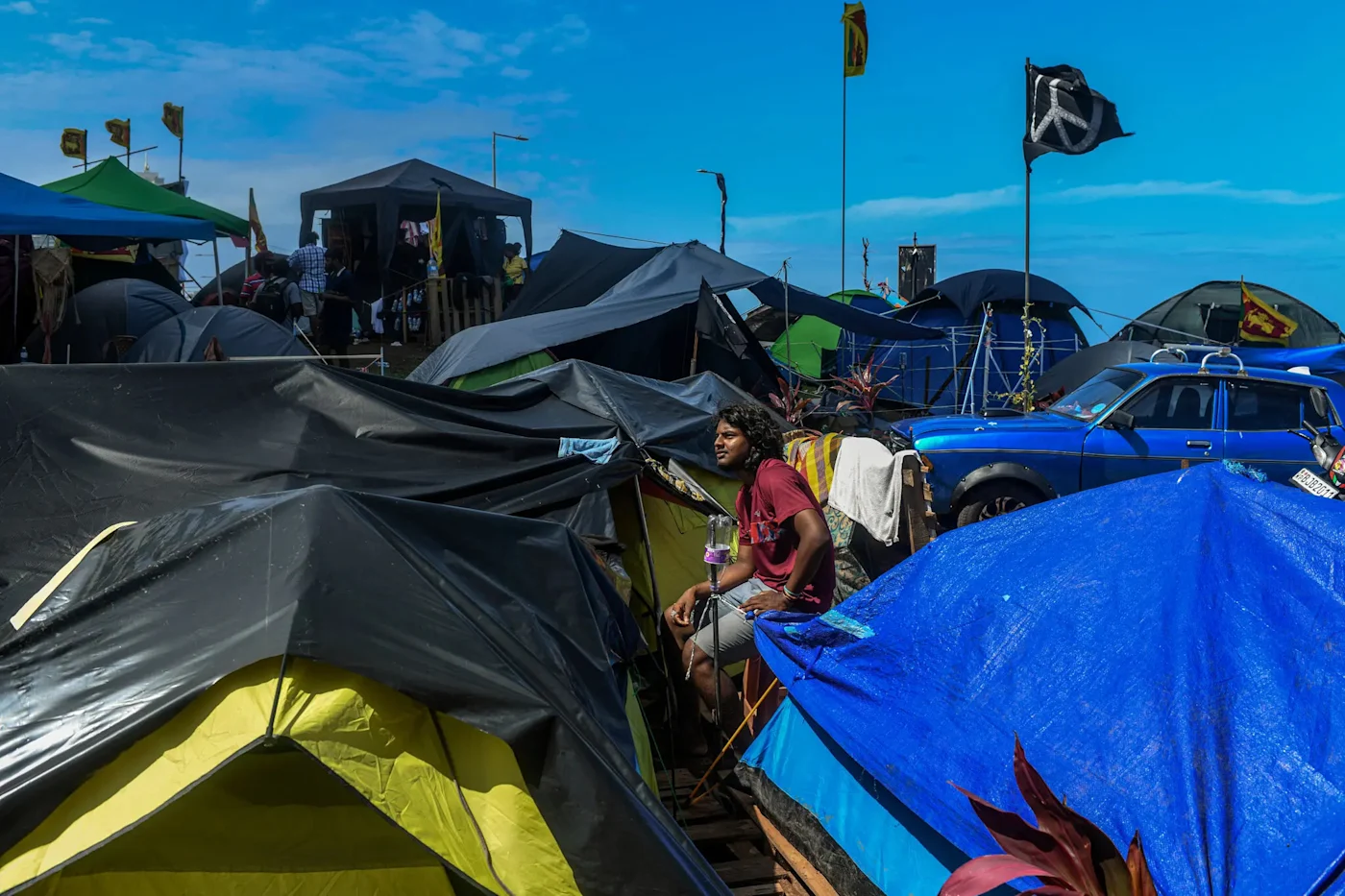
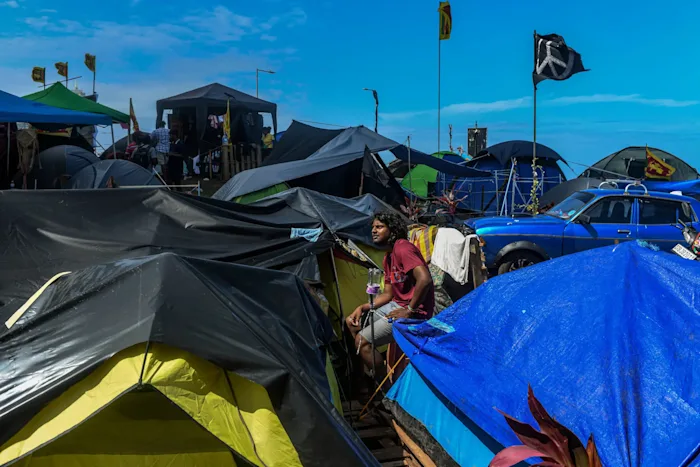
There was so much going on there. It winded up and down and up and down. The cinema was showing movies. There were concerts. The library had a constant flow of people through it. There was a college, a people's university, with teach outs everyday. I would say it all reached its peak between April and May. Then we had to rebuild after the May 9 attack. It's also been like a constantly shifting and evolving space. We were there every day and there was so much to do…all while getting tear gassed.
What were the big turning points of the movement?
April 3 was when the first islandwide mass protest was planned. The government cracked down with an island-wide curfew. They shut down phone networks and blocked access to social media. That galvanized people: even the fence-sitters who on April 2 were not sure if they would step out, turned up on the 3rd. That state’s oppression of our right to protest really lit a fire. So when that curfew was lifted on April 4, it was huge. On April 3 as well, when that curfew was imposed, a lot of people still ventured out into the streets, protesting in their local areas, in their neighborhoods, on their streets, outside their houses. Considering the level of fear people lived in under the Rajapaksa regime, undermining Gotabaya’s power by breaking the curfew was a huge turning point. People were slowly starting to lose their fear and feel their own power. It felt like, “OK, we're part of something much bigger.”
After that was April 9, when the mass protest started at Galle Face, which later turned into the occupation. People were there for about two or three days protesting, and some just never left. People had traveled from way outside of Colombo, so they couldn't just go back to their city or their homes in the night. So a lot of people stayed overnight and then they just started occupying the space. And it became the village that it was. There was no plan for an occupation that we know of, or that anyone I know knew of. It just became an occupation spontaneously.
This spurred the establishment of similar occupations across the country as well. Another big turning point was May 9, when there was a state-sponsored attack against the Galle Face protesters and other protesters around the country. Armed goons tore down the settlement, burnt things, and attacked protesters. We saw these forces with our own eyes, and the police were really just letting it happen. The police barricade just let them in. Half of the crowd from Colombo just walked up and attacked the pro-government goons. And a lot of people escaped back to their villages. The army was harboring these pro-government goons when our people started attacking them.
That really garnered massive support from the rest of the public. The people that were occupying these spaces were viewed as the youth of the nation that were fighting for everybody else's rights. The whole maneuver really backfired on them, and May 9 ended up bolstering the movement. It made a lot of people angry.
Then came July 9, when we had the Ratama colombata [රටම කොළඹට] or “Whole Country to Colombo” protest. Some journalists reported that up to two million people were in the streets that day.7 It was a major turning point. The dust didn't settle from that for a few days. Demonstrators hung around and continued protesting. We were right up at the front gates of the Presidential Palace when people started breaking them down. There were so many people that we couldn't move at all, so when we got hit by tear gas, we couldn't flee. It was really hectic. That was the day that the three state buildings were taken. And then on July 13, a fourth building was taken.

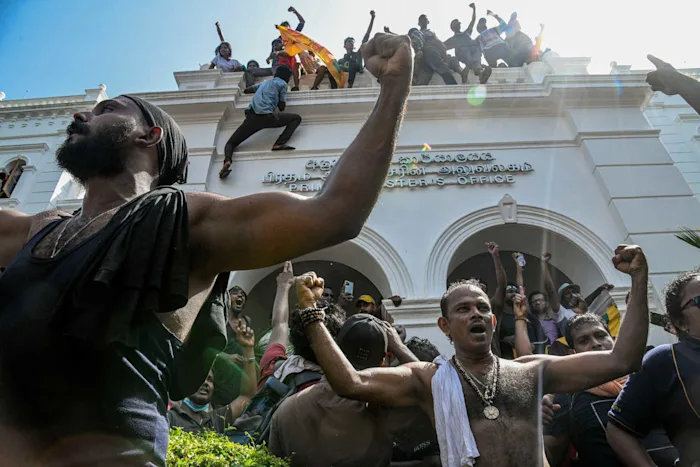
Another turning point occurred on July 22, when troops on Ranil’s orders came into GGG and broke half of it down and attacked protesters again.
One thing that has to be said as well is that, even prior to April 3, from February onwards there were sporadic protests happening all across the country, they were just more in rural areas. There were fishermen's protests and farmers’ protests. This is the first time that a crisis of this scale united everybody in shared frustration, because it affected us all in one way or another. It wasn't some isolated thing that the rest could just kind of ignore because it didn't affect them. But protests actually began happening in February.
What did the lead up to July 9 look like?
We had numerous meetings to come up with strategies to garner public support and get people more involved, even if it was not necessarily visiting the occupation site.
In the lead-up to July 9, we saw a lot of people sharing stuff on social media. But we had seen that throughout these four months. It was not until the morning of the 9th that we really realized how big it was going to be. Even by the time we arrived there, I don’t think we realized how big it was or was going to be.
Everybody was worried that public support was waning and that we were going to lose. I kept a journal throughout. And when I go back and read it, there are some pages where I've written: I had a lot of hope in the beginning of this movement, but now we’re losing. We have no support anymore. GGG is empty. The protests are getting smaller and more seldom. And then July 9th was a huge turnout.
So it was a pleasant surprise for a lot of us. But there was a lot of unnecessary celebration, in my personal opinion. At that point, we had still not seen a resignation from Gotabaya or any of the changes that we expected to come from this movement. People were just more celebrating the fact that this many people had come into the streets, which was a reason to celebrate. But it wasn't over at that point.
Why do you think that many people came on the 9th?
There was a lot of hype. There was a lot of traction on social media about the 9th. Information got out a lot that way. Plus, there were a lot of groups involved in spreading information.
In addition, the economic situation had just deteriorated further. People were desperate. That this movement blossomed to begin with was entirely due to frustration and desperation at this level: sitting in queues, not being able to feed your children, not having access to medical care or needed medicine. From every angle, people were just completely fed up. When this “Whole Country to Colombo” protest started being spread, people felt like “OK this is going to be the final push” to really get these narcissists out of power.
We already had poverty in Sri Lanka before this economic crisis. But it's just gotten worse. We speak from a privileged middle class perspective. But the majority of the people that came out on the 9th were not. We were a very small minority. It was frustration that drove people to use their last bits of petrol and diesel to get to Colombo for that protest.
Was there a plan to occupy the buildings or did that happen spontaneously?
I think it was half and half. There are a lot of groups inside Galle Face with different ideas about what the primary objective ought to be. But everyone knew we were going to march on that building, even if no one could know what kind of pushback we would see from the state forces. They met us with tear gas and water cannons. There were policemen in civilian clothes that brutally attacked protesters with batons as they jumped over the barriers. But all of these obstacles were rendered inoperative because there were just so many people, so the crowd overcame it all and broke through every last barricade. And then after the last barricade, all that remained was just to get in there, which people eventually achieved. The state was firing live rounds, and people were injured. But once the crowd made it to the entrance of the building, there was nothing left to do but to go inside.
We didn't even find out that the Secretariat and Temple Trees had been taken until we attempted to shuffle through these massive crowds and get back to the main road. Only then did we realize the full extent of what had taken place that day. Since all of the occupied buildings were taken over at roughly the same time, one is tempted to say that there had to be some level of organization and communication. But it was half and half.
What happened between July 9 and 13?
In the days after the 9th, the state propaganda machine worked very hard to highlight the looting and damage to state property that had occurred during those few days.
Some people who’d been around the movement for some time argued that this is public property, that the repairs would come out of taxpayers money, and did everything in their power to protect these properties and to prevent looting, stealing, and damage. But honestly it was just anarchy. It was just completely out of control and those who attempted to do crowd control were outnumbered.
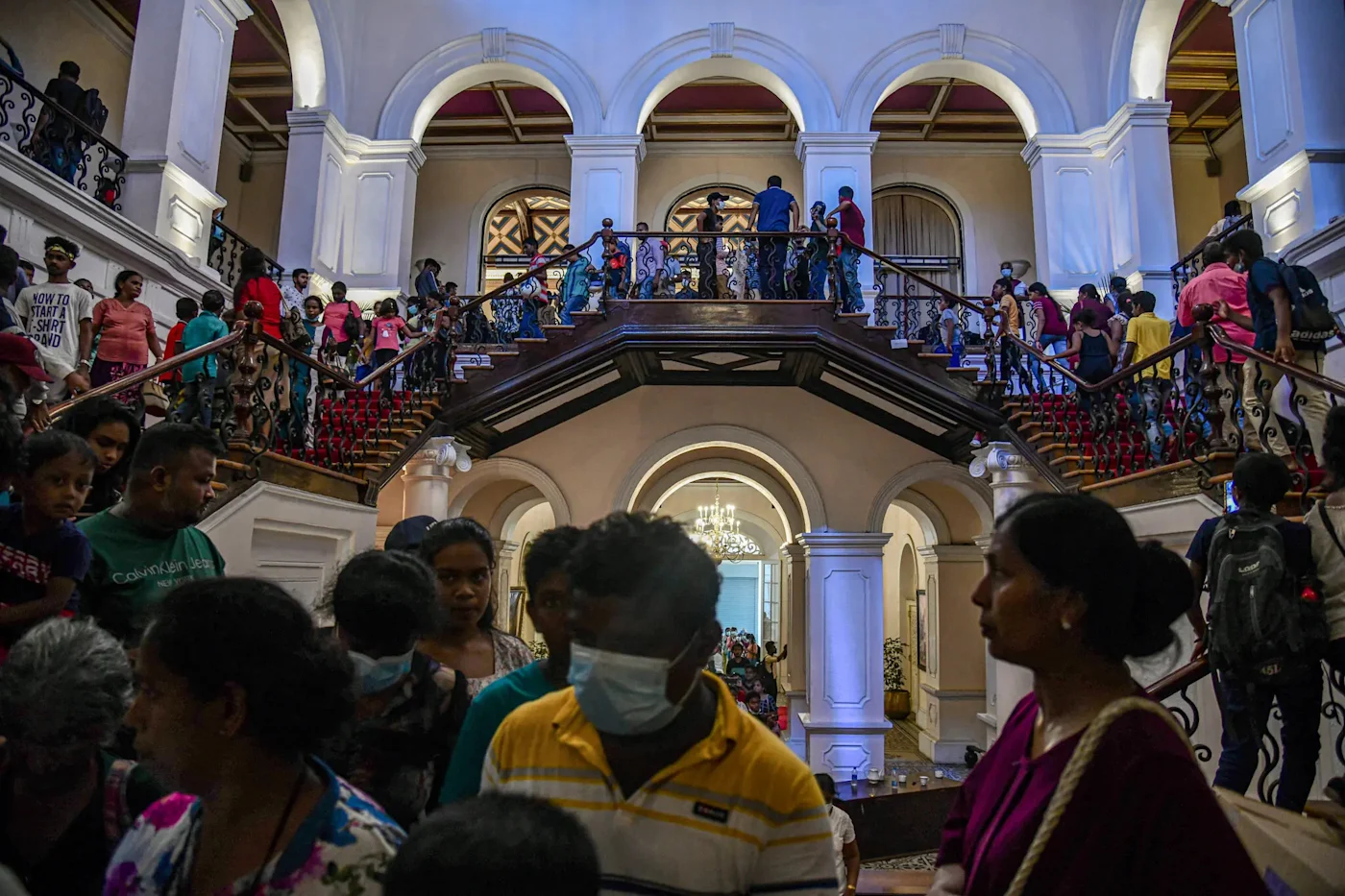
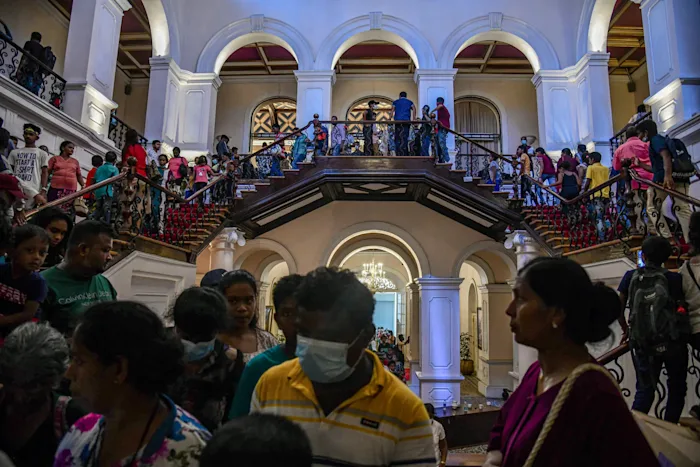
Whenever protesters occupied state buildings, there was always a group of super violent people that were trying to destroy state property. Apart from breaking down the barricades, there were incidents where some people just stormed into the building and set them on fire. That happened at Ranil’s house on the 9th. The fire was at risk of spreading to the houses around his house, but those same people didn't let the fire trucks enter.
It lost us a lot of support from the general public, who said, “look what these protesters have done. They've gone and ruined these buildings.” Some feel that this negatively impacted the support for the movement in the public eye. For weeks all they could talk about in Parliament was the fact that these ministers' houses were burned down.
What do you see as some of the missed opportunities of the movement so far?
At the time, it felt like a mistake to have given up the buildings that had been occupied on the 9th. It seemed like our only leverage for achieving any of the changes that we wanted, especially because Gotabata had not resigned at that point. Perhaps the buildings could have been used as leverage to get rid of Ranil?
However, having had the hindsight of a few weeks, probably that’s incorrect. There was no other option. With the pressure from the Bar Association at the time, and the fact that between the 9th and the 13th we lost a lot of public support, there was no choice. Especially because it was next to impossible to control the crowds inside the occupied buildings. The public was developing an increasingly negative view of the Aragalay every day, seeing it as the destruction of law and order. Plus, if state forces had decided to enter and used force against the people occupying the buildings, we might have seen bloodshed. So for the sake of the lives of the people that have been involved in the movement, maybe it was a smart move? But at the time, it felt like a mistake.
What are the main debates that have happened within the movement?
From the beginning there were familiar divides between non-partisans and leftists, and between a more anarchist-inclined ideology and more constitutional types who wanted to see things being done according to the rule of law and such — even though our constitution is an archaic piece of shit.
There has been a huge debate over whether the movement had been taken over or hijacked by the left. During the insurgencies in our history, lots of people lost their lives. The older generation that lived through this period still have memories of blood in the rivers, and bodies everywhere. This fear of the left was capitalized on by groups that wanted us to lose public support. There was a heavy left presence throughout the Aragalaya from the very beginning. And there still is.
Without groups like the Inter University Students Federation (IUSF, also known as Anthare) and the teachers federations, without the trade unions that staged a hartel (an island wide strike), none of this would have been possible. All of this contributed to putting pressure on the government. People were happy to use them when it felt helpful, and then turn around the next day and be like, “oh, the left is hijacking this movement.” It’s like the Scooby-doo thing where they pull the mask off and reveal that “it's actually been the JVP all along.” In fact, they have been present, but the movement was not all run by the JVP, nor was it taken over by the JVP or the left.
There is, in sense, still a military occupation of the North and East. This is one of the major issues with the government budget is that, since the civil war ended, which was only in 2009, there was no decrease in the military budget. The Tamils in the North and East have been oppressed for generations. They have been dealing with these kinds of issues for generations. The power cuts, the lack of fuel, the lack of access to medicine, state oppression, police brutality. They were dealing with all this before the war, and they still are now that the war ended. These are things that they've been protesting for generations too. But there has been hardly any coverage of this in the media that reaches the rest of the country.
When this movement started, a lot of these groups in the North and East, the Tamil minority, looked at it with amusement. This is stuff that they've been dealing with since childhood. Now that it's affected the Sinhala majority, the people in the South, it suddenly became this islandwide movement that was put on this pedestal. “Wow. Look what these people have achieved by protesting. How brave of these people for protesting.” But actually we were privileged people that knew we were somewhat safe.
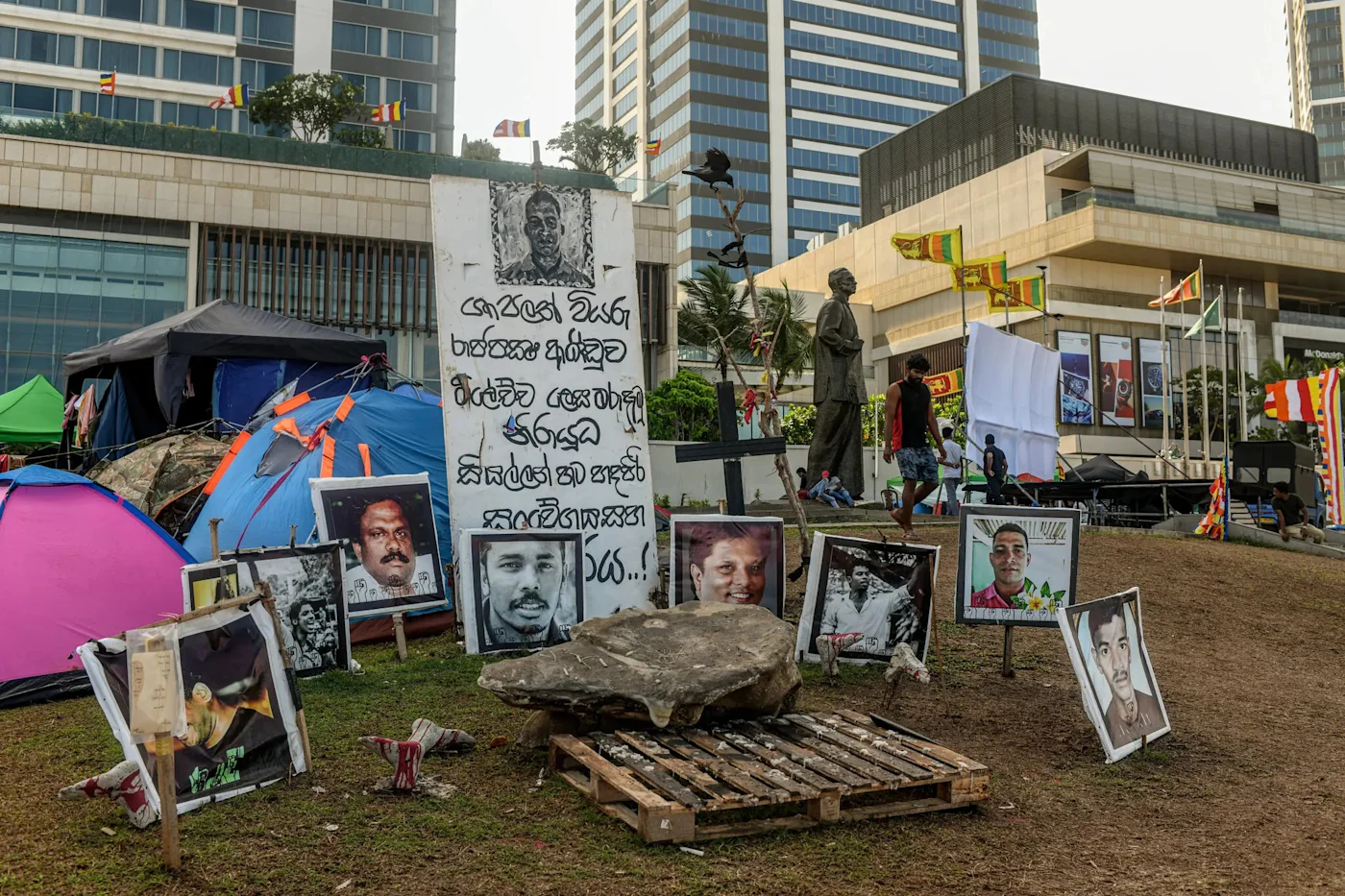

There was a memorial held at GGG for the Mullaitivu massacre, which happened at the end of the civil war. There was a lot of pushback around this. Some thought it would discredit the Aragalay by associating it with the LTTE.8 After all, anything that can be is taken out of context and used against us. Other people argued that if we can't hold things like this, how can we say that GGG and this movement has brought about the unity that everybody is celebrating?
There were so many smaller arguments that cropped up throughout the whole movement. Even in terms of taking the buildings in the latter stages. Some people were conflicted about the way it was handled and how the crowds were controlled.
Some people disagreed with how the free food was given out. “OK, now this is just becoming like a soup kitchen for people that are not even necessarily protesters. They're just coming there for food.” But how can you not give food to hungry people that are starving because of the economic crisis that we're fighting against, just because they're not protesters like us per se? And anyway, it still brought numbers to Galle Face.
What role has the left and the various political parties played in the camps and in the movement more generally?
Numbers. They brought the numbers for sure. But also, because of the nature of the IUSF and similar factions, having been engaged in these kind of protests for years, facing off against tear gas and barricades and cannons was really nothing new for them. They, to an extent, took a leading role in the beginning by being on the front lines, because this was not something new to them. They've been doing it for years. For a lot of us that joined this movement, it was the first time we had ever experienced the feeling of tear gas, or of doing battle face to face with a police officer. They showed us that there's nothing to be that afraid of, that we can do this. Whenever these groups came in, they came with thousands. It really gave us the morale and the numbers that we needed to achieve any of this. But that by no means meant that it was a JVP movement. Because there were so many other groups, factions and individuals present throughout.
What are some of the debates that took place within your own group?
Some people steadfastly refused to come to the table with politicians, and they stuck to this position throughout. Others changed their minds and joined meetings with politicians, apart from the Pohottuwa Party.9 No one really knew what the right thing to do was. But it drove a wedge between the people that did and didn’t meet with politicians.
What were the main limits the movement encountered?
This is the first time in Sri Lanka that different groups of people across gender identities, class, and socioeconomic background have come together. It was a whole mix of different people. Naturally people who were similar did band together. But there's been a lot of cross contamination and composition. A lot of gender, age, and class barriers were broken as well, which was a huge thing. I think this was one of the biggest things to come out of these protests.
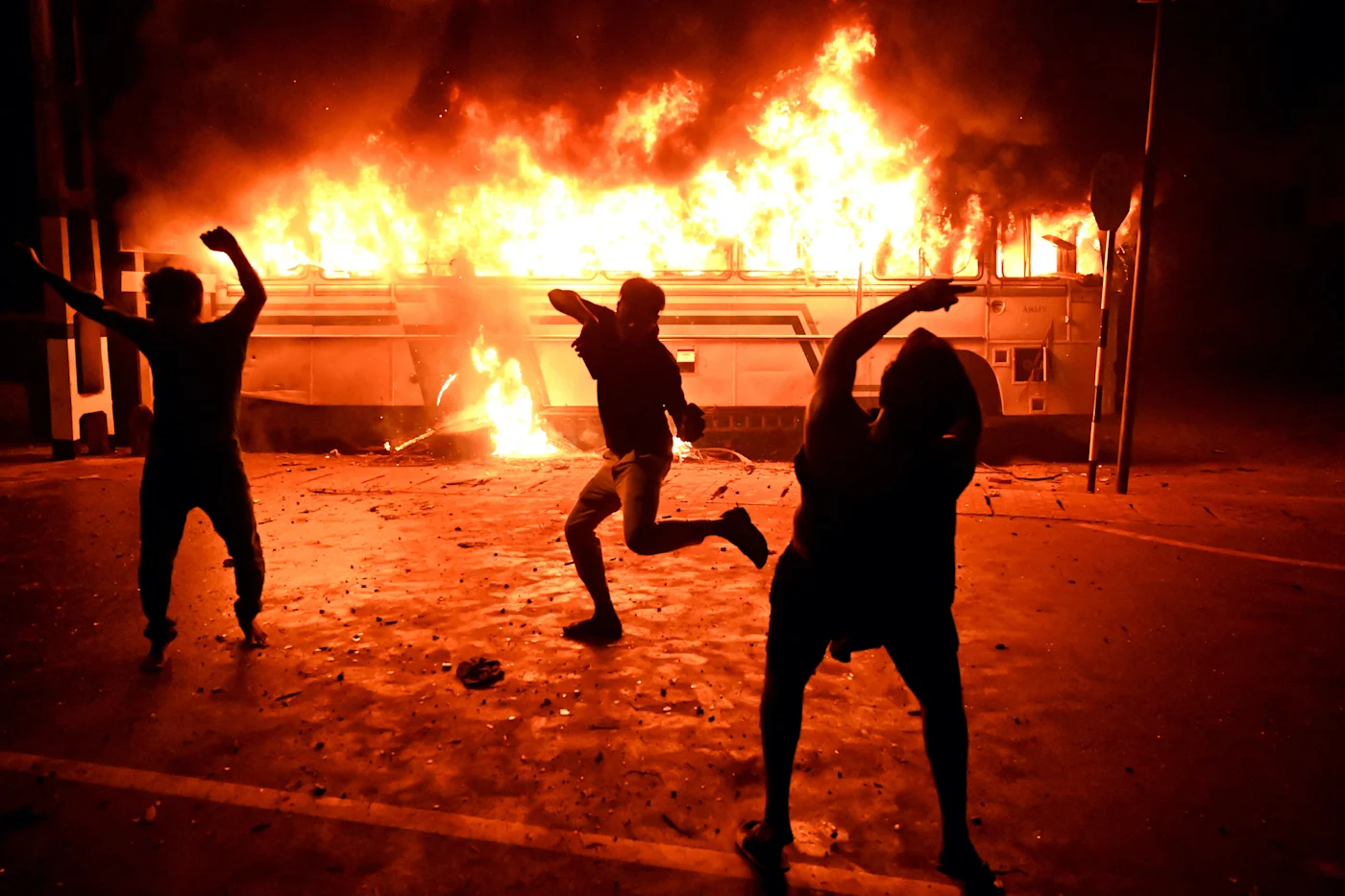
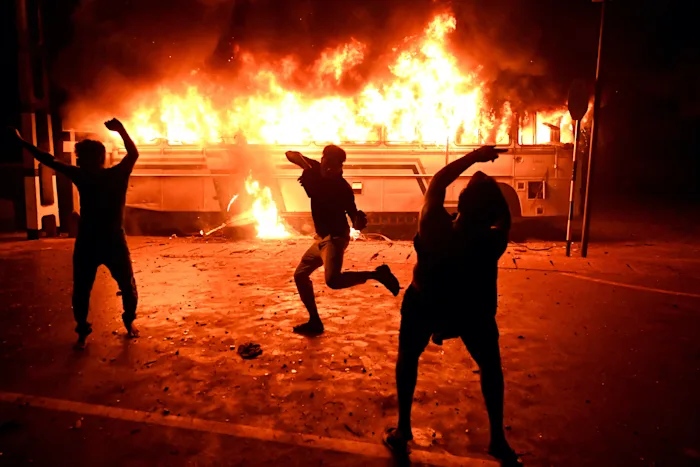
But within GGG, we saw all of the same issues from the wider society reflected there. Even though there was an unprecedented level of unity, and the breaking of class, gender, and racial barriers, it was still dominated by Sinahala-speaking men. You still had a minority of women on the megaphones. And the minorities were still minorities even within the movement. Even though there was definitely more acceptance and more inclusivity, there's a long way to go before we see the kind of country that we want to see.
Did those separations become more intense or open rifts at certain points?
I think it was a bit subtle. We were at a protest in Fort and we had a lot of friends from the LGBT community with us. They were being discriminated against by other protesters for waving the pride flag. So there were small problems like that. I wouldn't say they're like big disagreements, but like smaller, more subtle disagreements where there's still no unity possible.
It was always a minority that was pissed off, and they never made a big enough scene about it, because they wanted to prioritize the main goals of the movement. I'm part of the GGG Women’s circle. There have been constant complaints from women that it's too few women speaking at press conferences, too few women on the megaphone, too few women are involved in organization and strategizing. So these complaints have existed. The LGBTQIA+ community tent was only set-up really recently. There were trans friends who were discriminated against and faced a lot of hardship and harassment by just being there. There were things like that throughout. Everybody kind of worked on it to the best of their capabilities. But it wasn't like there was a complete vanishing of all these issues. It was just like the wider society reflected there.
Some of the people at GGG who were pitching tents and staying there were not receptive to the ideas given by people like us. Because we never physically stayed there in tents. Since we were there from the beginning, we gained the respect and became comrades with people from the library and people from the kitchen and other groups. We helped each other out. But certain tents always looked at us like outsiders.
There was somewhat of a disconnect in communication between protesters who were occupying and the ones that weren't occupying. To some of us who were not staying there, it felt like we were being excluded from certain decision-making processes and meetings.
Did it feel that people got radicalized over the course of the movement?
Definitely. A lot of these people would have never thought they would go and break barricades and face tear gas and suffering. After years of oppression and just being scared of the state, to see youth standing on barricades shouting Api baya nah! [අපි බය නෑ], which means we are not afraid — that was a huge thing.
One thing I've personally witnessed: there was this girl who was a drama actor who’d been involved in these protests. She had a very small build, and one day I watched her get hit with a water cannon. It knocked on her ass, her glasses flew off, and she was seriously injured. But that afternoon at the camp, I saw her smiling and talking about other stuff, as if it wasn’t a big deal. It's such a beautiful thing to see, because people have been radicalized by this movement so much. It's just like a normal thing to them.
What do you think the next phase of the struggle looks like now that Ranil is in power?
I think it is definitely a change in chapters. I don't think the strategies that we made use of to get rid of the Rajapaksas can be applied to Ranil, because he is reputed to be a cunning politician in the way he goes about things. So currently what we're dealing with is the propaganda war.
What are the lessons from Sri Lanka that might be useful elsewhere?
If people are in similar economic and political situations, don’t wait. Start organizing and strategizing now.
What do you plan to do now?
We are looking into other modes. Not of dissent, but of revolutionizing life by moving out of the system; to create these off-grid, self-sustained communities, where we can grow our own food and self-govern. We have been swept along and inspired by our comrade’s idea to start a plant-based permaculture off-grid living community, so we can get away from the system and, with the impending food crisis, we can grow our own food and live in harmony with nature, using eco-friendly sustainable building methods. That is something we are looking forward to. We won't have to give a shit about the constitution and the laws anymore. Because we're going to be growing our own food and generating our own power. We won’t have to care about money and the fluctuations in the currency anymore.
That's the plan for now, so let's see how it goes and if we can actually find a land where we can start this sustainable lifestyle that we're looking for, away from the system and oppression. It's revolutionary in its own way.
We don’t believe the Aragalay will stop. It will evolve into what it is required to be under Ranil now. It’s a wait and see phase, during which we can restrategize. But that doesn't mean we're going to stop. We are going to keep making graphics and finding ways to put information and our ideas out here. And we’re both going to keep fighting the fight.
Any concluding thoughts?
Fuck the police.
(July 31, 2022)
Images: Atul Loke et al.
Notes
1. People’s Liberation Front in English. A Marxist-Leninist party which is now the third largest party in Sri Lankan Parliament. [All footnotes have been added by the editors]↰
2. Ranil is accused of overseeing the Batalanda Detention Center which was used to interrogate and kill dissidents and leftists during the second JVP insurrection. The many tortures in Batalanda included skinning, beating, eye-gouging, burning, rape, and dismemberment. It is speculated that Batalanda's horrid tales were purposefully leaked out to strike fear and demoralize the population.↰
3. Mirihana is a suburb of Colombo where Gotabaya's personal residence is located. On March 31, thousands protested outside of Gota’s house. During clashes with police and soldiers, protesters stormed a barricade and a bus and several police vehicles were set on fire. That night spontaneous protests spread throughout the city.↰
4. Former Prime Minister Mahinda Rajapaksa is Gotabaya Rajapaksa’s older brother, and widely seen as the family patriarch. He was forced to resign as prime minister on May 9.↰
5. Gota Go Gama, or GGG, is the name of the main occupation site, which is located at Galle Face Green in Colombo.↰
6. Z. is a graphic designer. They used to do graffiti while in school and has always intuitively had a fuck the system attitude. After losing themselves in a corporate job for a decade, they started doing freelance work, moved back to Colombo during Covid, and found themselves in the midst of the Aragalaya. Unaware of the occupation, Z. happened to pass by Galle Face one day in early April and by chance ran into a friend who had started a food distribution tent for the protests. They have been heavily involved ever since. J.’s first foray into activism was when she stuck up posters on her school fish tank because she thought the fish were being mistreated. When nothing was done about it, she began stealing a fish once a week from school. She has been involved in feminist and environmental movements, and because of that had some connection with other people at the Aragalaya when it started. She was living in the south of Sri Lanka at the time. But when she realized this was becoming something huge, she knew that she had to be at the heart of it. She gave up her house and job and moved back to Colombo. She moved in with her parents to ensure that she didn’t have other commitments and could be as involved as possible. She stayed overnight but never set up a tent at the occupation, because “It is funny that I say this now, but every time I felt like ‘OK, I'm going to pitch my tent and move in here,’ it felt like, ‘oh, it's too late, it's about to end any week now.’ And then a month later I would think “shit, I should have just pitched the tent when I thought about it last time.’” Both Z. and J. have been involved with running a mutual aid food distribution tent at the occupation and have been on the frontlines of the protests. Z. has been making anonymous designers and posters for the movement, although many of the ones they printed were destroyed during the raid on May 9. J. has been filming and livestreaming from the frontlines, to provide an alternative to the media’s portrayal. This interview has been lightly edited for clarity and concision. Z. and J.’s responses have been edited together.↰
7. For context, Sri Lanka has a population of 22 million.↰
8. The Liberation Tigers of Tamil Eelam.↰
9. The party associated with the Rajapaksas.↰